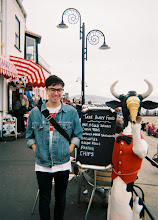Heather ordered a package from Topshop.com which arrived today. The item was sent in a brown polka-dot paper bag as packaging. I began to play with the bag by placing it on my head as a kind of mask. I started to think about the cliched image of the person wearing a brown paper bag on their head and decided to photograph it. Without my glasses the bag seemed featureless and almost unrecognisable, but once I put the glasses on and began to shape the bag around my head it started to take on more human qualities. I began to pull faces beneath the bag, I'm still not sure, but I felt that you could work out the expression or emotion conveyed even through the bag.



I noticed a likeness to Magritte's painting Les Amants/The Lovers (below). I began to consider looking at ideas of identity, anonymity and, without meaning to sound too trite, the idea of metaphorical and physical masks. This also tied quite well into my intention of acquiring a Polaroid 403 or 'Passport' camera which takes four images at once or four separate images, as I have previously stated, I believe there is an intrinsic link between Polaroid and 'the truth'. There is also a tenuous link between the 'truth' behind the passport image and the way in which it ties in with identity. Many photographers and artists have dealt with identity through the use of the 'passport' style photo-booth image, an idea which as even slipped into mainstream film in the form of the French film Amelie.

Les Amants is a painting in which the cloths have been used to obscure and hide the faces of the sitters, the suit of the man suggests the idea of the 'everyman'. The image has become iconic and appeared in popular music and culture and yet the face obscured by cloth has deep psychological connections to Rene Magritte's childhood, his mother having committed suicide and being dragged from the River Sambre with her face partially covered by her night dress, indeed this would require further study in a separate post as it raises particularly interesting Oedipal concerns. I think the anonymity of the paper-bag is an interesting area to explore and so intend to create some 'anonymous' portraits, obscuring the face of the sitters with the paper bags.
Below is an example of an image taken with the Polaroid 403 camera, using Fuji FP-100c, (the same film stock I was using for my previous project). These cameras and this kind of film was used up until fairly recently to take standard passport photographs, thus is inseparable from the idea if identity. Further below is an image of the collected work from a project by Japanese artist called Tomoko Sawada. Her work deals with the maleability of identity and the 'truth' of a passport photo.



















